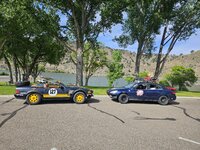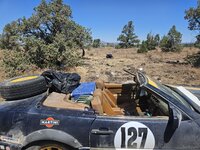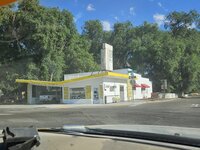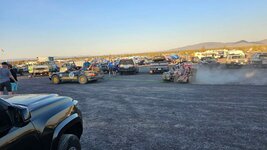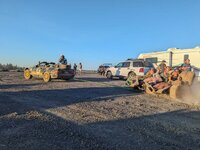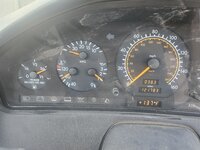Navigation
Install the app
How to install the app on iOS
Follow along with the video below to see how to install our site as a web app on your home screen.
Note: This feature may not be available in some browsers.
More options
Style variation
-
Hi Guest !
Welcome to the 500Eboard forum.
Since its founding in late 2008, 500Eboard has become the leading resource on the Internet for all things related to the Mercedes-Benz 500E and E500. In recent years, we have also expanded to include the 400E and E420 models, which are directly related to the 500E/E500.
We invite you to browse and take advantage of the information and resources here on the site. If you find helpful information, please register for full membership, and you'll find even more resources available. Feel free to ask questions, and make liberal use of the "Search" function to find answers.
We hope you will become an active contributor to the community!
Sincerely,
500Eboard Management
You are using an out of date browser. It may not display this or other websites correctly.
You should upgrade or use an alternative browser.
You should upgrade or use an alternative browser.
The $500 500SL Offroadster
- Thread starter Beater400E
- Start date
Made it home from the first Gambler 500 trip of the year. The car did remarkably well. I had a rear lower shock bushing disintegrate on day one, so there was a clunk throughout the whole trip. All the gear in the rear of the car made the rear sit down lower than I wanted, so I'll have to look at options to support the weight better.
I'm thinking of possibly converting to aftermarket air shocks in the rear. Should be fairly straightforward. Then I can just air up the shocks as needed to support the weight when I'm loaded down heavily.
The air conditioning was mediocre. That's a funny thing to complain about in the world of Gamblers. The vast majority of cars have no air conditioning at all. This car probably has leaks in the vacuum control system which are causing the center dash vents and floor vents to not work. I'd like to sort that out before the next run if I can.
I really want to do something with the rear diff. It desperately needs lower gears. I have to manually shift to 1st every time I stop if I want to get off the line reasonably. I'd also really like an LSD of some sort. I was thinking ASD might be an interesting way to go. I'm not sure what exactly is involved though.
Ideally, I'd source an ASD diff with a low gear ratio (if such a thing exists) and then rig up some kind of system to control the locking functionality. I don't know what donor cars to look for, or if they were even available with 3.4x-up gears. Obviously I need to stay with a 210mm ring gear if there's any hope of the diff surviving.
I'm just starting to research the ASD thing. If anyone has any good info on donors, let me know.
I'm thinking of possibly converting to aftermarket air shocks in the rear. Should be fairly straightforward. Then I can just air up the shocks as needed to support the weight when I'm loaded down heavily.
The air conditioning was mediocre. That's a funny thing to complain about in the world of Gamblers. The vast majority of cars have no air conditioning at all. This car probably has leaks in the vacuum control system which are causing the center dash vents and floor vents to not work. I'd like to sort that out before the next run if I can.
I really want to do something with the rear diff. It desperately needs lower gears. I have to manually shift to 1st every time I stop if I want to get off the line reasonably. I'd also really like an LSD of some sort. I was thinking ASD might be an interesting way to go. I'm not sure what exactly is involved though.
Ideally, I'd source an ASD diff with a low gear ratio (if such a thing exists) and then rig up some kind of system to control the locking functionality. I don't know what donor cars to look for, or if they were even available with 3.4x-up gears. Obviously I need to stay with a 210mm ring gear if there's any hope of the diff surviving.
I'm just starting to research the ASD thing. If anyone has any good info on donors, let me know.
Nope. Not sure at all. It would probably be good to figure that out too.Are you sure clutches for the ASD are still available? Even if you locate an ASD differential, the likelihood that the clutches are toast is fairly high, I believe.
It's not an assigned number. This is not what you'd call "organized." I put 127 on because if you find the letter of the alphabet whose ordinal matches each digit you get "ABG," the abbreviated form of the Gambler slogan "always be gambling."Looks like fun!!
Pity they could have assigned you 129 as your number...
Many people have asked why I chose 127, and I always challenge them to figure it out. So far no one has correctly guessed without big hints. Honestly I was surprised no one figured it out this weekend. There were 4,000 people at this weekend's event, and this car was one of the highlights. At one point I was doing laps around Deschutes County Fairgrounds towing a couch full of people. Everyone saw the car, but nobody guessed the meaning of the number.
I happened to just see this comment and thought it might be of some interest to you:Made it home from the first Gambler 500 trip of the year. The car did remarkably well. I had a rear lower shock bushing disintegrate on day one, so there was a clunk throughout the whole trip. All the gear in the rear of the car made the rear sit down lower than I wanted, so I'll have to look at options to support the weight better.
I'm thinking of possibly converting to aftermarket air shocks in the rear. Should be fairly straightforward. Then I can just air up the shocks as needed to support the weight when I'm loaded down heavily.
The air conditioning was mediocre. That's a funny thing to complain about in the world of Gamblers. The vast majority of cars have no air conditioning at all. This car probably has leaks in the vacuum control system which are causing the center dash vents and floor vents to not work. I'd like to sort that out before the next run if I can.
I really want to do something with the rear diff. It desperately needs lower gears. I have to manually shift to 1st every time I stop if I want to get off the line reasonably. I'd also really like an LSD of some sort. I was thinking ASD might be an interesting way to go. I'm not sure what exactly is involved though.
Ideally, I'd source an ASD diff with a low gear ratio (if such a thing exists) and then rig up some kind of system to control the locking functionality. I don't know what donor cars to look for, or if they were even available with 3.4x-up gears. Obviously I need to stay with a 210mm ring gear if there's any hope of the diff surviving.
I'm just starting to research the ASD thing. If anyone has any good info on donors, let me know.

I've been back from the Oregon Gambler for about a week and have begun addressing the biggest issues with the car. The two biggest problems were the center AC vents not working and the rear suspension sitting too low when the trunk is fully loaded.
I did some troubleshooting and identified that the vacuum block between the engine and the climate control system was cracked. Apparently this is a very common issue on the R129. I got a brand new OE replacement for $40 and now the center vents work.
I took some measurements at the rear shocks and determined that air shocks for a Ford Econoline van were pretty close dimensionally and could probably be made to work. I ordered a set and went to work installing them. I ended up having to move the upper shock mount outboard about 10mm, and then cut a hole in the inner fender through which I could route the air lines. I then plumbed them to an air fitting under the gas door next to the gas cap. The air shocks make a huge difference. I've done some testing with them and the car drives much better with about 20-30 psi in the air shocks with nothing but the spare tire on the rear. Fully loaded I'm sure it will want a lot more, but that's the beauty of the air shocks. I can adjust them for whatever load I have.
The oil pressure gauge has only ever worked intermittently. The lower engine wiring harness was a mess. I ended up pulling the harness and just fully rebuilding it. All the connectors were easy enough to de-pin, unsolder, then solder to new wires and re-pin. Well, all except for the oil level sensor. That one just disintegrated when I looked at it. The rubber cover is unsalvageable, so I had to come up with another solution. I know the W124 cars use a single pin oil pressure sensor. I didn't have a spare connector for that since all my parts cars had two wire sensors, but after rummaging I discovered that my spare 400E gauge cluster had that same single pin connector on it. So I reused that. Removing the o-ring from the oil level sensor meant the single retention finger on the single pin connector had something to engage. In the end, the harness came out great.
Before:

After:

I also replaced the oil pressure sensor with one off another engine I have. It's used, so I don't expect perfection.
Oil pressure reads 3 bar cold, and 3 bar hot over maybe 1500-2000 RPMs, below 1500 it drops pretty low. Hot idle is under 1 bar. My ears tell me there's nothing to be concerned about. The car never makes any valve noise, so I'm confident oil pressure is fine. Is <1 bar normal at hot idle? My 400E shows around 2 bar at hot idle.
I also replaced the beloved 15mm power steering reservoir hose. I'm glad I just bought a couple meters of that hose a while back. Every M119 car I've touched needed that hose replaced.
I'm planning to install a skid plate under the engine soon. The engine oil pan is the first thing a big rock would hit if the trail gets rough. I'd like to add some protection for that.
I'm still on the lookout for a diff with shorter gears. I've found a couple and am just trying to negotiate the best price. I had thought about an ASD diff, but clutch plates are not readily available. I'm sure I could have originals relined or have custom clutches made, but the cost of procuring an ASD diff, plus the cost of new custom clutches makes the whole thing pretty pricey. Probably not worth it.
I'm also working on procuring some replacement parts for the soft top control. I'd love to have a fully functional roof. They're a little spendy to fix though, so I'm on the lookout for bargains.
I'm also planning to flush the cooling system and refill with a 60/40 mix and some Purple Ice, and then install a resistor in the high speed fan circuit, just to help keep it cool.
I'm also considering a FGS valve body. I can get one for around $100 from the pick and pull. I'm seriously considering it. I don't know that it's really worth $100 to add FGS to this beater car, but the way I'm kind of thinking about it is that this car is just a shed full of spare parts that I can drive. If some day I decide I'm done with it, all the good parts can come back out and anything I don't need can get sold. That FGS valve body should be able to easily be sold for more than the $100 it will cost me.
That reminds me. Does anyone know what differences there are between the 722.3 found in the W140 500SEL and the 500SL? I know they're not the same exact model, but I'm curious what differences there might be and whether there would be any advantage to running the 500SEL trans instead of the 500SL trans.
I did some troubleshooting and identified that the vacuum block between the engine and the climate control system was cracked. Apparently this is a very common issue on the R129. I got a brand new OE replacement for $40 and now the center vents work.
I took some measurements at the rear shocks and determined that air shocks for a Ford Econoline van were pretty close dimensionally and could probably be made to work. I ordered a set and went to work installing them. I ended up having to move the upper shock mount outboard about 10mm, and then cut a hole in the inner fender through which I could route the air lines. I then plumbed them to an air fitting under the gas door next to the gas cap. The air shocks make a huge difference. I've done some testing with them and the car drives much better with about 20-30 psi in the air shocks with nothing but the spare tire on the rear. Fully loaded I'm sure it will want a lot more, but that's the beauty of the air shocks. I can adjust them for whatever load I have.
The oil pressure gauge has only ever worked intermittently. The lower engine wiring harness was a mess. I ended up pulling the harness and just fully rebuilding it. All the connectors were easy enough to de-pin, unsolder, then solder to new wires and re-pin. Well, all except for the oil level sensor. That one just disintegrated when I looked at it. The rubber cover is unsalvageable, so I had to come up with another solution. I know the W124 cars use a single pin oil pressure sensor. I didn't have a spare connector for that since all my parts cars had two wire sensors, but after rummaging I discovered that my spare 400E gauge cluster had that same single pin connector on it. So I reused that. Removing the o-ring from the oil level sensor meant the single retention finger on the single pin connector had something to engage. In the end, the harness came out great.
Before:

After:

I also replaced the oil pressure sensor with one off another engine I have. It's used, so I don't expect perfection.
Oil pressure reads 3 bar cold, and 3 bar hot over maybe 1500-2000 RPMs, below 1500 it drops pretty low. Hot idle is under 1 bar. My ears tell me there's nothing to be concerned about. The car never makes any valve noise, so I'm confident oil pressure is fine. Is <1 bar normal at hot idle? My 400E shows around 2 bar at hot idle.
I also replaced the beloved 15mm power steering reservoir hose. I'm glad I just bought a couple meters of that hose a while back. Every M119 car I've touched needed that hose replaced.
I'm planning to install a skid plate under the engine soon. The engine oil pan is the first thing a big rock would hit if the trail gets rough. I'd like to add some protection for that.
I'm still on the lookout for a diff with shorter gears. I've found a couple and am just trying to negotiate the best price. I had thought about an ASD diff, but clutch plates are not readily available. I'm sure I could have originals relined or have custom clutches made, but the cost of procuring an ASD diff, plus the cost of new custom clutches makes the whole thing pretty pricey. Probably not worth it.
I'm also working on procuring some replacement parts for the soft top control. I'd love to have a fully functional roof. They're a little spendy to fix though, so I'm on the lookout for bargains.
I'm also planning to flush the cooling system and refill with a 60/40 mix and some Purple Ice, and then install a resistor in the high speed fan circuit, just to help keep it cool.
I'm also considering a FGS valve body. I can get one for around $100 from the pick and pull. I'm seriously considering it. I don't know that it's really worth $100 to add FGS to this beater car, but the way I'm kind of thinking about it is that this car is just a shed full of spare parts that I can drive. If some day I decide I'm done with it, all the good parts can come back out and anything I don't need can get sold. That FGS valve body should be able to easily be sold for more than the $100 it will cost me.
That reminds me. Does anyone know what differences there are between the 722.3 found in the W140 500SEL and the 500SL? I know they're not the same exact model, but I'm curious what differences there might be and whether there would be any advantage to running the 500SEL trans instead of the 500SL trans.
Nice work on the vents, air shocks, and harness!I've been back from the Oregon Gambler for about a week and have begun addressing the biggest issues with the car. The two biggest problems were the center AC vents not working and the rear suspension sitting too low when the trunk is fully loaded.
Old oil pressure sensors can read lower than normal. My guess is that's what you are seeing. Factory spec claims 0.5 bar is acceptable at hot idle, reality should be more like 1.0-1.2 bar minimum at hot idle. This will vary with the oil viscosity and temp of course.I also replaced the oil pressure sensor with one off another engine I have. It's used, so I don't expect perfection.
Oil pressure reads 3 bar cold, and 3 bar hot over maybe 1500-2000 RPMs, below 1500 it drops pretty low. Hot idle is under 1 bar. My ears tell me there's nothing to be concerned about. The car never makes any valve noise, so I'm confident oil pressure is fine. Is <1 bar normal at hot idle? My 400E shows around 2 bar at hot idle.
Yep, same here, every 124 that I've owned needs the low-pressure p/s hoses replaced.I also replaced the beloved 15mm power steering reservoir hose. I'm glad I just bought a couple meters of that hose a while back. Every M119 car I've touched needed that hose replaced.
I think there may be aftermarket clutch plates available, but it's still a lot of work to replace those if available at a decent price. I did this job nearly two decades ago (!) when building my first LSD.I'm still on the lookout for a diff with shorter gears. I've found a couple and am just trying to negotiate the best price. I had thought about an ASD diff, but clutch plates are not readily available. I'm sure I could have originals relined or have custom clutches made, but the cost of procuring an ASD diff, plus the cost of new custom clutches makes the whole thing pretty pricey. Probably not worth it.
This - in bold - above: ^^^I'm also considering a FGS valve body. I can get one for around $100 from the pick and pull. I'm seriously considering it. I don't know that it's really worth $100 to add FGS to this beater car, but the way I'm kind of thinking about it is that this car is just a shed full of spare parts that I can drive. If some day I decide I'm done with it, all the good parts can come back out and anything I don't need can get sold. That FGS valve body should be able to easily be sold for more than the $100 it will cost me.
Take the side plates off the VB before installing, inspect for broken springs. You can replace the K1/K2 springs/pistons with new if desired, parts are relatively inexpensive.
I believe the tailshaft housing is different between the 124/140 version and the 129, along with a different rear/trans mount. The internals should all be identical.That reminds me. Does anyone know what differences there are between the 722.3 found in the W140 500SEL and the 500SL? I know they're not the same exact model, but I'm curious what differences there might be and whether there would be any advantage to running the 500SEL trans instead of the 500SL trans.

Take the side plates off the VB before installing, inspect for broken springs. You can replace the K1/K2 springs/pistons with new if desired, parts are relatively inexpensive.
I picked up the FGS valve body from the junk yard yesterday. Haven't installed it yet, but I probably will this weekend. I'll check the K1/K2 springs before I install it. The trans seems to shift well, so if there aren't any broken springs is there any benefit to swapping? I have most of a Superior kit on the shelf left over from a 722.4 repair I did last year, so I may have replacements on hand if there's any benefit to it.
I also replaced some vacuum lines that failed on my last offroad test. They were old and crunchy and apparently one of them popped loose and found its way into the serpentine belt. That ripped the line loose and took out another one with it. Fortunately I had both of those sizes of vacuum line on the shelf, so fixing it was pretty easy.
I also replaced the old crunchy serpentine belt. I was hoping replacing the belt would eliminate a little belt squeal during the 1-2 shift, but it did not. It might be marginally better with the new belt, but when second gear engages at wide open throttle the belt slips momentarily. I'd assume that if the air conditioning was off it probably wouldn't do it. I haven't tested that directly though.
The belt tensioner seems to be fine. This has the second design, with the automatic tensioner, and a 6 rib belt. The spring tension seems pretty strong and the bearings in the pulley feel fine. Anyone have any suggestions for shutting up that belt squeal?
If the FGS VB has good springs, just install and see how it shifts. I've found a broken spring or two in maybe 1 out of 10 VB's so it's worth checking before installing, given how much fun it is dropping the pan.
The belt squeal is strange, with a new belt. I'd clean all the pulley grooves with solvent and maybe try a spritz of belt dressing if nothing else works. With clean pulleys and normal tension, it should be quiet. Also spin each pulley with the belt off to confirm nothing is weird with any bearings.
The belt squeal is strange, with a new belt. I'd clean all the pulley grooves with solvent and maybe try a spritz of belt dressing if nothing else works. With clean pulleys and normal tension, it should be quiet. Also spin each pulley with the belt off to confirm nothing is weird with any bearings.
I installed the FGS valve body. It works great. I'm very happy with the results. I'd still like to swap the diff, but FGS is a big help. I also installed the cooling fan resistor and flushed the coolant, and I fabricated a custom skid plate to protect the oil pan from rocks. The car still wants to run at 120 degrees all the time. It doesn't generally go above that, but it sits at 115-120 pretty much all the time. Granted, it's nearly 100 degrees Fahrenheit out, and the air conditioning is on full, so it's going to be hot.
My bigger concern at the moment is oil pressure. At hot idle it's now reading 0. At 2000 RPMs it reads 2 bar, and above 2500 it reads 3 bar. Again, I don't hear or see any indication of low oil pressure from the engine itself. I suspect it's a bad sensor. I went ahead and ordered a cheap replacement sensor. I hope it's somewhat accurate, even if it doesn't last forever. I'm not willing to spring for OE on a beater car like this.
I had the car out for a long drive today and at one point the ETA quit responding and the ASR light came on. The car continued to run, and the ETA would respond once I pushed beyond 50% throttle. I pulled over and shut the car off for a moment, and then restarted and everything was fine. No problems since. Hopefully it's just a fluke. I've put over 1000 miles on the car at this point and that's the only time it's done that.
My bigger concern at the moment is oil pressure. At hot idle it's now reading 0. At 2000 RPMs it reads 2 bar, and above 2500 it reads 3 bar. Again, I don't hear or see any indication of low oil pressure from the engine itself. I suspect it's a bad sensor. I went ahead and ordered a cheap replacement sensor. I hope it's somewhat accurate, even if it doesn't last forever. I'm not willing to spring for OE on a beater car like this.
I had the car out for a long drive today and at one point the ETA quit responding and the ASR light came on. The car continued to run, and the ETA would respond once I pushed beyond 50% throttle. I pulled over and shut the car off for a moment, and then restarted and everything was fine. No problems since. Hopefully it's just a fluke. I've put over 1000 miles on the car at this point and that's the only time it's done that.
Is the viscous fan fully engaged and roaring up to 3500rpm? With AC on max, coolant temp should be ~105C max even in 100F ambients. If the fan is roaring you should have airflow, next up is making sure the radiator/condenser fins are not blocked, and making sure the thermostat isn't defective or somehow modified.
The throttle issue you described is what's known as "limp mode". Turning the ignition off will clear it until the next time, repeat as needed. Check fault codes on the E-GAS module to get an idea of the root cause.
BTW, looks like you'll get to enjoy some 110°F temps next week. Sweet!

The throttle issue you described is what's known as "limp mode". Turning the ignition off will clear it until the next time, repeat as needed. Check fault codes on the E-GAS module to get an idea of the root cause.
BTW, looks like you'll get to enjoy some 110°F temps next week. Sweet!
I haven't checked the clutch. I'll give that a look.Is the viscous fan fully engaged and roaring up to 3500rpm? With AC on max, coolant temp should be ~105C max even in 100F ambients. If the fan is roaring you should have airflow, next up is making sure the radiator/condenser fins are not blocked, and making sure the thermostat isn't defective or somehow modified.
Just stumbled across this by chance:
Yeah, that's us. You can see the Offroadster in that first picture.Just stumbled across this by chance:
I checked out the fan clutch and it appears to be dead. It's an original Sachs. No roaring when hot. I rummaged around and found a clutch from one of the W140s I'd parted out. It's an aftermarket clutch, and was a little grimy, but I swapped it in anyway. The fan now roars, although the car still gets pretty dang hot.
It's certainly possible that the "new" aftermarket clutch is less than perfect. I can get a brand new Chinese clutch for $36. I'm definitely not spending $600 for an OE clutch. I'm skeptical that the clutch is the issue at this point though.
It's only about 90 degrees Fahrenheit out right now, but with the air conditioning on full the car runs right at or just above the 120 degree C mark on the gauge. Obviously the gauge or sender could be inaccurate, but when the needle moves north of 120, the air conditioning compressor disconnects. That tells me the system has probably gone over pressure due to the temperature. Of course the condenser is in front of the radiator, so in theory high coolant temperatures should not cause the air conditioning to go over temp/pressure. Lack of adequate air flow could. It's certainly possible that the fan clutch is still the issue.
The thing is, the car will run at 120 even at 75 mph on the interstate. I doubt that would be the case if the fan clutch was the only issue. I'm sure the thermostat is due for changing, and I'm not opposed to doing so, but I'm skeptical that the thermostat would be restricting flow enough for the car to run at 120, but no more. Just seems oddly specific for a thermostat failure.
I have an electric fan from a W220 on the shelf. I know those work great, but I'd need a PWM controller and I don't think I really want to spend the money on that.
I probably will get a new thermostat and fan clutch, just for peace of mind if nothing else. Still trying to think what else could cause the car to run hot like this though.
It's certainly possible that the "new" aftermarket clutch is less than perfect. I can get a brand new Chinese clutch for $36. I'm definitely not spending $600 for an OE clutch. I'm skeptical that the clutch is the issue at this point though.
It's only about 90 degrees Fahrenheit out right now, but with the air conditioning on full the car runs right at or just above the 120 degree C mark on the gauge. Obviously the gauge or sender could be inaccurate, but when the needle moves north of 120, the air conditioning compressor disconnects. That tells me the system has probably gone over pressure due to the temperature. Of course the condenser is in front of the radiator, so in theory high coolant temperatures should not cause the air conditioning to go over temp/pressure. Lack of adequate air flow could. It's certainly possible that the fan clutch is still the issue.
The thing is, the car will run at 120 even at 75 mph on the interstate. I doubt that would be the case if the fan clutch was the only issue. I'm sure the thermostat is due for changing, and I'm not opposed to doing so, but I'm skeptical that the thermostat would be restricting flow enough for the car to run at 120, but no more. Just seems oddly specific for a thermostat failure.
I have an electric fan from a W220 on the shelf. I know those work great, but I'd need a PWM controller and I don't think I really want to spend the money on that.
I probably will get a new thermostat and fan clutch, just for peace of mind if nothing else. Still trying to think what else could cause the car to run hot like this though.
If the fan is roaring with the spare aftermarket clutch, you are moving air... next check is to verify the condenser & radiator fins are clear and not blocking airflow.
After that see if the radiator itself might be bad, i.e. outlet temp not much below inlet temp. I don't know reference data to look for on this - need to test some of my "good" cars one of these days.
Less likely, but possible, is the water pump is bad. If the impeller is either loose on the shaft, OR the spacing from impeller to housing is too large, you'll have very little flow and cooling will be terrible / 120C.
Again, if the ran is roaring up to at least 3000rpm, a new clutch won't help.

After that see if the radiator itself might be bad, i.e. outlet temp not much below inlet temp. I don't know reference data to look for on this - need to test some of my "good" cars one of these days.
Less likely, but possible, is the water pump is bad. If the impeller is either loose on the shaft, OR the spacing from impeller to housing is too large, you'll have very little flow and cooling will be terrible / 120C.
Again, if the ran is roaring up to at least 3000rpm, a new clutch won't help.

The radiator and condenser look very clean as far as airflow. No debris anywhere.
I got out my infrared temp gun and took a bunch of measurements. Temperature at the hose just before the thermostat is 140 F. Temperature on the entire water pump and thermostat housing is around 240 F. I believe that means I have a flow issue with the thermostat or water pump. Flow is happening. I'm reading about 230 F at the top of the radiator, and 130F at the bottom. I believe that indicates good radiator performance and good air flow. If anything, the slower flow may be generating much cooler temps at the lower hose, although it's not enough to lower the actual engine temps.
Incidentally I also discovered I have another Sachs fan clutch on the shelf. No idea if it's actually any good. I probably won't mess with that right now, but I can try it if I need to later.
I'm going to replace the thermostat first and see what happens. If that doesn't solve it, I'll yank the water pump and inspect or replace it.
I got out my infrared temp gun and took a bunch of measurements. Temperature at the hose just before the thermostat is 140 F. Temperature on the entire water pump and thermostat housing is around 240 F. I believe that means I have a flow issue with the thermostat or water pump. Flow is happening. I'm reading about 230 F at the top of the radiator, and 130F at the bottom. I believe that indicates good radiator performance and good air flow. If anything, the slower flow may be generating much cooler temps at the lower hose, although it's not enough to lower the actual engine temps.
Incidentally I also discovered I have another Sachs fan clutch on the shelf. No idea if it's actually any good. I probably won't mess with that right now, but I can try it if I need to later.
I'm going to replace the thermostat first and see what happens. If that doesn't solve it, I'll yank the water pump and inspect or replace it.
I think you are correct... there's a flow issue, either t-stat or water pump. I would do the same thing, replace t-stat first and see what happens.
Remember there are different types of thermostats which are not interchangeable. The switch occurred during 1995 USA model year, and I think all your M119's are 1994 or older, so they should all be interchangeable (116- part number, more info here).
Would be nice to get this sorted prior to the afterburners kicking in on Tuesday...
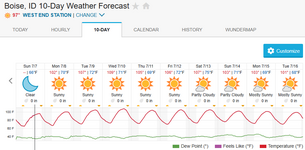
Remember there are different types of thermostats which are not interchangeable. The switch occurred during 1995 USA model year, and I think all your M119's are 1994 or older, so they should all be interchangeable (116- part number, more info here).
Would be nice to get this sorted prior to the afterburners kicking in on Tuesday...

Yup. I actually have one 95 with the later style and then a bunch of the earlier ones. Fairly sure this car has the earlier 116 style. The 94 S500 I had that had the broken engine block had all new cooling system parts. Pretty sure the thermostat and water pump were brand new. I'll see if I can find those. I may just swap the assembly in and be done with it.Remember there are different types of thermostats which are not interchangeable. The switch occurred during 1995 USA model year, and I think all your M119's are 1994 or older, so they should all be interchangeable (116- part number, more info here).
T-stat swap is fairly quick... replacing the entire water pump is a few hours more work. I'd avoid the pump swap if not needed.
Also - the 1993 car will have the "solid" harmonic balancer, which must come off to access one single stupid bolt at the bottom of the pump. Removing the balancer is a chore in itself. The late (mid-95 and newer) balancers have a spoked design and you can R&R the water pump without removing the balancer. I've always wondered if we could "upgrade" older engines to the late balancer design without messing up, uh, balance.

Also - the 1993 car will have the "solid" harmonic balancer, which must come off to access one single stupid bolt at the bottom of the pump. Removing the balancer is a chore in itself. The late (mid-95 and newer) balancers have a spoked design and you can R&R the water pump without removing the balancer. I've always wondered if we could "upgrade" older engines to the late balancer design without messing up, uh, balance.
Ah, I see that now. You're right. That would be a pain. Ok, maybe I'll just swap in the thermostat.Also - the 1993 car will have the "solid" harmonic balancer, which must come off to access one single stupid bolt at the bottom of the pump. Removing the balancer is a chore in itself. The late (mid-95 and newer) balancers have a spoked design and you can R&R the water pump without removing the balancer. I've always wondered if we could "upgrade" older engines to the late balancer design without messing up, uh, balance.
My 95 engine has that spoked balancer, but uses the same crank and flex plate as the earlier engines. I can't think of any reason why the later balancer wouldn't work. I'd assume it's more of a damper than a balancer anyway.
Ok, I just pulled out all my spares. I have two early style pumps and one late. Both of the early pumps are missing their thermostats. The late one has a thermostat, but I'm pretty sure it's not compatible.
So I'll need to source a new one. Unless...
Allow me to open a can of worms. What about running with no thermostat? I'm not worried about cold weather warm up. I've heard all kinds of opinions regarding running without a thermostat. The most common argument I've heard for running a thermostat, aside from warming up the engine, is that it creates needed backpressure in the system, which raises the boiling point of the coolant. I'm not sure I totally buy that. I believe overall system pressure is a function of temperature and cap pressure, not pump flow and resistance thereto.
Thoughts? Opinions? Arguments? Hateful epithets?
So I'll need to source a new one. Unless...
Allow me to open a can of worms. What about running with no thermostat? I'm not worried about cold weather warm up. I've heard all kinds of opinions regarding running without a thermostat. The most common argument I've heard for running a thermostat, aside from warming up the engine, is that it creates needed backpressure in the system, which raises the boiling point of the coolant. I'm not sure I totally buy that. I believe overall system pressure is a function of temperature and cap pressure, not pump flow and resistance thereto.
Thoughts? Opinions? Arguments? Hateful epithets?
The M119 (and most Mercedes) cooling system design cannot cool properly without the thermostat installed. It's not a simple 1-way valve as in many old domestic V8 engines. It's a 2-way valve that bypasses the radiator when cold, then starts to mix in some cool water from the radiator when partly open. When fully open, the t-stat blocks off the return path of hot coolant from the block so the water pump only ingests cool water from the radiator. With the t-stat removed, there's no way to prevent hot water from recirculating.
More details here:
TLDR:


More details here:
https://www.500eboard.co/forums/misc/Manuals/Servicev3.2/W124/w124CD1/Program/Engine/104/20-0050.pdf
TLDR:


You're right. I see that with the later style thermostat I have here. I wonder why those cars (apparently) didn't have issues. Doesn't matter. I ordered a new one.The M119 (and most Mercedes) cooling system design cannot cool properly without the thermostat installed. It's not a simple 1-way valve as in many old domestic V8 engines. It's a 2-way valve that bypasses the radiator when cold, then starts to mix in some cool water from the radiator when partly open. When fully open, the t-stat blocks off the return path of hot coolant from the block so the water pump only ingests cool water from the radiator. With the t-stat removed, there's no way to prevent hot water from recirculating.
More details here:
https://www.500eboard.co/forums/misc/Manuals/Servicev3.2/W124/w124CD1/Program/Engine/104/20-0050.pdf
TLDR:
View attachment 196070
View attachment 196071
I realized yesterday that my aux fans are not coming on at low speed. The high speed works, but no low speed. I know that's not the cause of my engine running hot, but I'd still like to fix it.
The K9 relay does not appear to be getting a ground signal from the climate control unit. I know I'm venturing away from our beloved W124s here a bit, but does anyone happen to know of anything I should check aside from the climate control unit itself? The climate control all seems to work aside from this one thing, which is strange. I verified continuity across the wiring, so if the climate control unit is supplying ground it should be activating the relay.
If I artificially provide ground to that relay pin the low speed fans activate, so I know the rest of the system is fine.
I'm wondering (hoping) that there's some other condition that the AAC control isn't seeing before it would send the signal to turn on the low speed fans. To the best of my knowledge, the fans should be on any time the AC conpressor is on.
The K9 relay does not appear to be getting a ground signal from the climate control unit. I know I'm venturing away from our beloved W124s here a bit, but does anyone happen to know of anything I should check aside from the climate control unit itself? The climate control all seems to work aside from this one thing, which is strange. I verified continuity across the wiring, so if the climate control unit is supplying ground it should be activating the relay.
If I artificially provide ground to that relay pin the low speed fans activate, so I know the rest of the system is fine.
I'm wondering (hoping) that there's some other condition that the AAC control isn't seeing before it would send the signal to turn on the low speed fans. To the best of my knowledge, the fans should be on any time the AC conpressor is on.
I guess I fixed it?
I ended up pulling the AAC control unit out and opening it up to look for any obvious burned or damaged components or cracked solder joints. I didn't find any. I decided to just slightly bend the pin responsible for the connection of the low speed aux fan trigger. I figured there was a chance that the female bushing might be loose enough that the male pin was not making contact. I put it back together and now it works.
I'm not sure if it was the bent pin or just taking it apart and putting it back together, but it works. I hate not knowing, especially since I have little faith the problem won't return. But I guess I shouldn't look a gift horse in the mouth.
I ended up pulling the AAC control unit out and opening it up to look for any obvious burned or damaged components or cracked solder joints. I didn't find any. I decided to just slightly bend the pin responsible for the connection of the low speed aux fan trigger. I figured there was a chance that the female bushing might be loose enough that the male pin was not making contact. I put it back together and now it works.
I'm not sure if it was the bent pin or just taking it apart and putting it back together, but it works. I hate not knowing, especially since I have little faith the problem won't return. But I guess I shouldn't look a gift horse in the mouth.
This is not quite correct, although I sometimes wish it was, because it sure would be easier to troubleshoot. The [low speed] fans turn on based on refrigerant pressure [for the 124 - see post below with more info]. It appears the R129 uses a different switch than most 124, and triggers the low speed fan at 20 bar (290 psi!), then shuts it off below 16 bar (230psi). [Edit: The pressure switch may trigger high speed fans on the 129.]To the best of my knowledge, the fans should be on any time the AC conpressor is on.
Those numbers are way high, the early 124 (1986-89?) had a similar switch that was replaced with one that turns the fans on/off at 16/12 bar, respectively. The lower-pressure switch runs the fan more often. If you ever evacuate the system you could replace the Green switch with the Red.
That said, in 100F ambients, there's a decent chance the pressures will be high enough to trigger the 20 bar switch...

Last edited:
Interesting. I thought the pressure switch engaged the high speed circuit.This is not quite correct, although I sometimes wish it was, because it sure would be easier to troubleshoot. The fans turn on based on refrigerant pressure. It appears the R129 uses a different switch than most 124, and triggers the low speed fan at 20 bar (290 psi!), then shuts it off below 16 bar (230psi).
Good call. I might even consider doing that proactively. It would be nice to charge the system by weight to ensure the charge is correct. Performance seems decent, so I suspect it's probably fine, but it wouldn't hurt to evacuate it and find out for sure.Those numbers are way high, the early 124 (1986-89?) had a similar switch that was replaced with one that turns the fans on/off at 16/12 bar, respectively. The lower-pressure switch runs the fan more often. If you ever evacuate the system you could replace the Green switch with the Red.
The high speed fans trigger based on engine temp, normally on at 107°C and off in the high 90's.Interesting. I thought the pressure switch engaged the high speed circuit.
HOWEVER: Per the chart below, it appears the 129 has different triggers for low vs high speed fans. If that data is correct, it seems the low fan on the R129 is supposed to turn on at 100°C engine temp, and the high fan triggers at 107°C *or* at refrigerant pressure above 20 bar.
Good call. I might even consider doing that proactively. It would be nice to charge the system by weight to ensure the charge is correct. Performance seems decent, so I suspect it's probably fine, but it wouldn't hurt to evacuate it and find out for sure.

Ok that makes sense. The wiring diagram I was looking at in WIS only had the pressure switch on the high speed side of the circuit. Different from the W124.HOWEVER: Per the chart below, it appears the 129 has different triggers for low vs high speed fans. If that data is correct, it seems the low fan on the R129 is supposed to turn on at 100°C engine temp, and the high fan triggers at 107°C *or* at refrigerant pressure above 20 bar.
That does suggest that changing the pressure switch would only impact when the high speed circuit engages. I could make the high speed circuit engage earlier by swapping to another switch. Honestly I probably won't bother though. Between the cool harness resistor and a new thermostat and functioning fan clutch, I'd bet a lower temp switch wouldn't make much difference.
The other thing this chart shows is that when coolant temps rise above 121-123 C the air conditioning will cycle on and off at 20 second intervals, and above 126-128 C coolant temps the air conditioning will completely turn off. That matches what I was seeing in my testing, which makes me believe that replacing the thermostat and/or water pump will probably take care of the air conditioning turning off at high temps. I had assumed it was going over pressure and turning off, which would not necessarily be caused by high coolant temps, but if coolant temp alone will cause the air conditioning to disconnect then I have my explanation there.
This thing should have fantastic air conditioning by the time I'm all done with it. Kind of funny for a $500 car and given the fact I'll probably be driving with the top down most of the time.
I pulled the thermostat out today and made three discoveries.
First, it's the later style thermostat. The water pump has obviously been replaced, and it would appear a used OE pump was installed. I'm basing that on the fact that the thermostat has a date code of 1995. So someone took a 95-96ish water pump and thermostat and tossed it in this car. Incidentally, they installed a 1992 water pump pulley with 8 ribs for some reason.
That leads to the second discovery. When I replaced the belt, I apparently had the belt one rib off on the bottom of the 8 rib water pump pulley. This was causing the belt to wear rapidly, and I suspect may have been the cause of the squeal I heard during WOT upshifts. I corrected the alignment. We'll see if that fixes it.
Finally, I tested the thermostat by boiling it in water on the stove. At a full boil the thermostat remained stubbornly closed.
I also tested the other late style thermostat I had on the shelf. It's dated 2012 and is an OE MB Wahler thermostat. It started opening around 180 degrees. It was wide open by 205. Since the replacement I'd ordered is the old style I'm just going to install this one and run it.
First, it's the later style thermostat. The water pump has obviously been replaced, and it would appear a used OE pump was installed. I'm basing that on the fact that the thermostat has a date code of 1995. So someone took a 95-96ish water pump and thermostat and tossed it in this car. Incidentally, they installed a 1992 water pump pulley with 8 ribs for some reason.
That leads to the second discovery. When I replaced the belt, I apparently had the belt one rib off on the bottom of the 8 rib water pump pulley. This was causing the belt to wear rapidly, and I suspect may have been the cause of the squeal I heard during WOT upshifts. I corrected the alignment. We'll see if that fixes it.
Finally, I tested the thermostat by boiling it in water on the stove. At a full boil the thermostat remained stubbornly closed.
I also tested the other late style thermostat I had on the shelf. It's dated 2012 and is an OE MB Wahler thermostat. It started opening around 180 degrees. It was wide open by 205. Since the replacement I'd ordered is the old style I'm just going to install this one and run it.
My dash temp reads a few degrees high, I don’t think it matters in terms of it’s not an engine management sensor input.Cooling system fixed. Ambient temperature... not so much. Actual temp is 105 F. Also, the gauge cluster lens is filthy. Guess that's what I get for offroading a convertible.
View attachment 196133
From what I’ve read, the sensor is under the front bumper and there are 2 types. One has a longer lead and is more difficult to replace the other has a plug near the sensor which makes replacement easier.
To be honest I live with it on mine and haven’t investigated at all which my 98 has and even if replacements are available etc.
I've started trying to figure out why the soft top and roll bar don't work. I began working through the diagnostic steps in WIS. After number of passed tests I found one that fails. The roll bar manual operation switch is supposed to send a signal to the soft top module. With the ignition on and the switch in its neutral position, pin Y3 on the soft top module should read between 4-6 volts. Mine reads 10.7 volts. According to WIS, this indicates a bad soft top module. Here's where it gets weird.
I already bought a replacement module, anticipating the module was probably bad. So I swapped in the replacement module, and got exactly the same reading.
So now I'm scratching my head. Either I have two modules that have failed in the same way, or something is wrong with my testing. I'm pretty sure I'm performing the test correctly, but I'm not 100% confident that the WIS documentation is flawless.
I reached out to the seller of the used module I'd purchased and told him what was going on, and he immediately refunded my purchase. That suggests that at the very least, the replacement module was untested.
Not sure what to do now. I'll probably just not worry about it for the time being, but at some point I'd like to get the soft top working.
I already bought a replacement module, anticipating the module was probably bad. So I swapped in the replacement module, and got exactly the same reading.
So now I'm scratching my head. Either I have two modules that have failed in the same way, or something is wrong with my testing. I'm pretty sure I'm performing the test correctly, but I'm not 100% confident that the WIS documentation is flawless.
I reached out to the seller of the used module I'd purchased and told him what was going on, and he immediately refunded my purchase. That suggests that at the very least, the replacement module was untested.
Not sure what to do now. I'll probably just not worry about it for the time being, but at some point I'd like to get the soft top working.
It does sound fishy that the seller immediately refunded however I agree that there is more likely something wrong somewhere to give the same fault twice than the coincidence of 2 similarly defective modules.
Obvious possible next steps are:
Borrow / try a known good roof module
Hook it up to a STAR or other decent diagnostic scanner and see if anything shows up
Well worth swapping out your fuses (you likely have the bullet style ones) and also make sure you have a decent battery as this can cause issues just to eliminate these.
I can hook my 98 up to STAR and upload screen shots of the HHT-Win actual values if this would help?
Obvious possible next steps are:
Borrow / try a known good roof module
Hook it up to a STAR or other decent diagnostic scanner and see if anything shows up
Well worth swapping out your fuses (you likely have the bullet style ones) and also make sure you have a decent battery as this can cause issues just to eliminate these.
I can hook my 98 up to STAR and upload screen shots of the HHT-Win actual values if this would help?
I appreciate it, but the 93 is a totally different animal from the 98. The WIS diagnostics are pretty simple. It does actually provide precise step by step tests using a multimeter that are pretty conclusive. The only real question is whether the 4-6 volt nominal value is correct, or if the documentation is inaccurate.I can hook my 98 up to STAR and upload screen shots of the HHT-Win actual values if this would help?
I suspect it's accurate, and that I have two modules that have both failed in similar fashion. These modules are known to be fragile, and it would seem likely that multiple modules could suffer the exact same failure.
Best practice is generally to test a suspected bad module by installing it in an otherwise known good car. Because it's possible that another issue within the problematic car may have been the cause of the damage to the suspected bad module, installing a known-good module just for testing can potentially cause the good module to fail. To avoid this, the better option is to put the suspected bad module in the good car.Obvious possible next steps are:
Borrow / try a known good roof module
Hook it up to a STAR or other decent diagnostic scanner and see if anything shows up
That's a long way of saying if I had a good module I wouldn't lend it to someone for testing because I'd be afraid my good module might get damaged.
In either case, I don't have access to a known good module or car, so I don't have any way of doing that.
Being a 93, this car has the old pulse count diagnostic system, so it's easy to pull codes. The roll bar module and soft top module are separate in this car. The roll bar module has no faults, and the soft top module displays code 25, which indicates implausible limit switch signals. Both soft top modules give this error.
My focus right now is mostly on the roll bar function though, since the soft top won't work without the roll bar functioning correctly. Of course the roll bar control runs through the soft top module, so it's possible to have a malfunctioning roll bar with a good roll bar module if there is a problem with the soft top module.
I guess I'm fortunate to have a small network of owners relatively close. When I had some problems recently, one guy came over and we did a swap and test both ways of our roof modules.
My only other suggestion is a test / repair service like this:

Maybe it is worth at least contact someone offering this type of service and explain your symptoms, you might get an answer to your question...
My only other suggestion is a test / repair service like this:

1298203926 1298200097 Mercedes R129 roof controller TEST SERVICE | eBay UK
, TEST ONLY. THIS SERVICE IS NOT FOR A SALE OF ITEM !, PURCHASING OR REPAIRING.
www.ebay.co.uk
Maybe it is worth at least contact someone offering this type of service and explain your symptoms, you might get an answer to your question...
If you suspect that, you really need to know before continuing to use roof modules as fusesI appreciate it, but the 93 is a totally different animal from the 98. The WIS diagnostics are pretty simple. It does actually provide precise step by step tests using a multimeter that are pretty conclusive. The only real question is whether the 4-6 volt nominal value is correct, or if the documentation is inaccurate.
I suspect it's accurate, and that I have two modules that have both failed in similar fashion. These modules are known to be fragile, and it would seem likely that multiple modules could suffer the exact same failure.
I figured out the soft top and roll bar issues, and I made some rear suspension changes.
I still don't know what to make of the voltage issue I was seeing with the soft top control module. I was obviously concerned that both modules were failing the same test, but I suspected there was at least a chance that either the test was incomplete or inaccurate, or I'd made a mistake in my testing. In either case, I decided to do more testing.
I checked a couple more things, and then I noticed this:

This is the limit switch that tells the soft top control module that the top is fully retracted into the top well. The metal top frame is supposed to press down on the blue switch tab. Instead, it's sliding down past it. Presumably something in the top mechanism is slightly tweaked.
Rather than trying to bend or properly adjust the top back to perfect alignment, I elected to just stick some spacers behind the limit switch to extend it out to where the top frame can contact it.
At that point the top and roll bar started working. It almost worked perfectly. I ended up having to adjust a couple limit screws to get everything to latch properly, but it now works flawlessly. No errors, no drama. It just works. I'm stoked.
Just in time too. The first Idaho Gambler 500 event is next weekend. With the top working, the car is almost ready. The air conditioning and cooling system are working great, and now the top is as well. I should be able to keep myself and the car nice and cool, which is good because I'm told we'll be climbing to over 7,000 feet on dirt trails in July heat.
In other news, I made some more suspension changes. The rear control arm angles were pretty extreme, and the air shocks had to be aired way up to maintain the needed ride height in the rear. My solution was twofold.
First, I machined some rear subframe drop spacers. I had to special order longer bolts to match as well. I dropped the subframe 2 inches. I also dropped the driveshaft carrier bearing an inch and a half, and the trans cross member just under an inch. That kept the driveline angles aligned from the trans output all the way back to the diff.
Angling the whole drive train down did make the radiator fan tilt up just a bit, but it's still we'll inside the shroud, so there shouldn't be any problems.
The diff dropping down also made a few little things interfere. I did some trimming here and there and I'll have to cut and reweld the tail pipe to compensate for the new angles.
The other thing I did was to swap out the rear springs. I took a bunch of measurements and then found a coils spring catalog online with dimensions. After much research I found what I needed. Late 90's Toyota Tacoma front coil springs are the same height, but with a higher spring rate, and are only slightly larger overall diameter. I figured I could make them work, so I ordered a set.
Sure enough, they worked. The higher spring rate let me eliminate the spring spacers I was using in the rear. The rear no longer sags and flops around. The car is pretty much perfect now with no air in the air shocks. I expect that it'll squat with the trunk fully loaded with gear for overlanding, but the air shocks should compensate for that.
I need to reassemble a bunch of interior now that the top is working, and then I'll get the car out for more testing. On a brief test drive I noticed a minor driveline vibration at wide open throttle at the top of first gear. When I lift off the throttle the vibration does away. I suspect I may have a failing rubber isolator on the driveshaft. I'll have a look tomorrow when I have the car on the lift for the tail pipe.
The car is almost perfect now. Some day I'd still like to find a 3.69 differential, but I'm too cheap to pay $350 for one, which is the cheapest I've found so far. Even with the stock 2.65s the car is still a ton of fun though.
I still don't know what to make of the voltage issue I was seeing with the soft top control module. I was obviously concerned that both modules were failing the same test, but I suspected there was at least a chance that either the test was incomplete or inaccurate, or I'd made a mistake in my testing. In either case, I decided to do more testing.
I checked a couple more things, and then I noticed this:

This is the limit switch that tells the soft top control module that the top is fully retracted into the top well. The metal top frame is supposed to press down on the blue switch tab. Instead, it's sliding down past it. Presumably something in the top mechanism is slightly tweaked.
Rather than trying to bend or properly adjust the top back to perfect alignment, I elected to just stick some spacers behind the limit switch to extend it out to where the top frame can contact it.
At that point the top and roll bar started working. It almost worked perfectly. I ended up having to adjust a couple limit screws to get everything to latch properly, but it now works flawlessly. No errors, no drama. It just works. I'm stoked.
Just in time too. The first Idaho Gambler 500 event is next weekend. With the top working, the car is almost ready. The air conditioning and cooling system are working great, and now the top is as well. I should be able to keep myself and the car nice and cool, which is good because I'm told we'll be climbing to over 7,000 feet on dirt trails in July heat.
In other news, I made some more suspension changes. The rear control arm angles were pretty extreme, and the air shocks had to be aired way up to maintain the needed ride height in the rear. My solution was twofold.
First, I machined some rear subframe drop spacers. I had to special order longer bolts to match as well. I dropped the subframe 2 inches. I also dropped the driveshaft carrier bearing an inch and a half, and the trans cross member just under an inch. That kept the driveline angles aligned from the trans output all the way back to the diff.
Angling the whole drive train down did make the radiator fan tilt up just a bit, but it's still we'll inside the shroud, so there shouldn't be any problems.
The diff dropping down also made a few little things interfere. I did some trimming here and there and I'll have to cut and reweld the tail pipe to compensate for the new angles.
The other thing I did was to swap out the rear springs. I took a bunch of measurements and then found a coils spring catalog online with dimensions. After much research I found what I needed. Late 90's Toyota Tacoma front coil springs are the same height, but with a higher spring rate, and are only slightly larger overall diameter. I figured I could make them work, so I ordered a set.
Sure enough, they worked. The higher spring rate let me eliminate the spring spacers I was using in the rear. The rear no longer sags and flops around. The car is pretty much perfect now with no air in the air shocks. I expect that it'll squat with the trunk fully loaded with gear for overlanding, but the air shocks should compensate for that.
I need to reassemble a bunch of interior now that the top is working, and then I'll get the car out for more testing. On a brief test drive I noticed a minor driveline vibration at wide open throttle at the top of first gear. When I lift off the throttle the vibration does away. I suspect I may have a failing rubber isolator on the driveshaft. I'll have a look tomorrow when I have the car on the lift for the tail pipe.
The car is almost perfect now. Some day I'd still like to find a 3.69 differential, but I'm too cheap to pay $350 for one, which is the cheapest I've found so far. Even with the stock 2.65s the car is still a ton of fun though.
That didn't last long. This morning I put the top up and the main lift cylinders started just hemorrhaging fluid all over the ground. Not too shocking. Now that the system is functional and able to build pressure, other cylinders are starting to blow out. I obviously just need to rebuild all cylinders. No big deal. I have a full seal kit for it and am comfortable tearing down and rebuilding the cylinders.
Unfortunately the seals blew out so badly that the top won't actually go up now. I won't have time to rebuild them all before the next Gambler event, but after that I will.
I got the interior reassembled and got the tail pipe cut and rewelded. I still need to replace the front driveshaft flex disc and the transmission mount, as well as a couple exhaust pipe gaskets. Those parts are on the way. Should have them all in the next couple days.
I got the car out and tested off road today with the revised rear suspension. It's fantastic. The geometry is much better, and the stiffer spring rate keeps the car from bottoming out on all but the most severe bumps.
The roll bar automatically deploys almost immediately off road, which is hilarious. I'll put it down, and within 30 seconds it'll be up again. I have a feeling we'll end up making a game out of how many times we can get the roll bar to automatically deploy.
Unfortunately the seals blew out so badly that the top won't actually go up now. I won't have time to rebuild them all before the next Gambler event, but after that I will.
I got the interior reassembled and got the tail pipe cut and rewelded. I still need to replace the front driveshaft flex disc and the transmission mount, as well as a couple exhaust pipe gaskets. Those parts are on the way. Should have them all in the next couple days.
I got the car out and tested off road today with the revised rear suspension. It's fantastic. The geometry is much better, and the stiffer spring rate keeps the car from bottoming out on all but the most severe bumps.
The roll bar automatically deploys almost immediately off road, which is hilarious. I'll put it down, and within 30 seconds it'll be up again. I have a feeling we'll end up making a game out of how many times we can get the roll bar to automatically deploy.
Well, I got impatient and ended up rebuilding the main lift cylinders and bow extension cylinders before the event and the top and roll bar were again working perfectly.
The Gem State Gambler 500 was this past weekend. It was a ton of fun and the Offroadster did great. The revised rear suspension was terrific. Handled the rough terrain wonderfully.
This year's route took us through the mointains of central Idaho from just outside Lowman, Idaho up to Deadwood Reservoir, and the old abandoned Deadwood Mine, over Pinyon Peak, and on to Yankee Fork.
Starting from the Payette river, we climbed north, past several active forest fires, until we eventually reached the Deadwood Dam and its reservoir. We checked out the dam, and then continued along the east side of the reservoir, through a couple water crossings, and on to the old Deadwood Mine site.
Deadwood Mine is a pretty cool old mining camp. Several large structures still stand in the area, but they are in rough shape at this point.

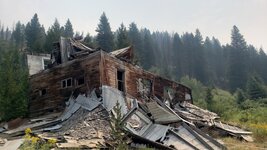
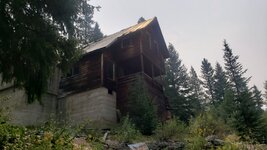
The adventurous can do a little further exploring in the area and may discover this incredible waterfall hidden nearby.


From there we headed east and climbed up to Pinyon Peak at an elevation of 9945 feet. The SL was the only Gambler car to make it to the very top. Everyone else struggled so much just to reach the ridge line, and elected not to attempt the road to the summit lookout.

When we reached the summit we were greeted by a very friendly forest ranger who was puzzled and amused by the presence of a Mercedes convertible at the top of his mountain. He told us in all his years working fire lookout towers, he'd never seen anyone bring a vehicle like that to the top. He came out and took pictures of the car to share with his colleagues.
When we went up to the peak, the rest of the Gamblers continued on down the back side of the mountain. We were capable of traveling much faster than most of them, so we told them we'd just catch up with them on the way down.
That was both a good and bad decision. Once we said goodbye to our new Forest Ranger friends, we took off and started ripping down the mountain to catch up with the rest of our group. That was a ton of fun. Basically my own private offroad race course. I had the ASR turned off and the rear suspension raised all the way up and basically rally drifted my way all the way down the mountain. I mentioned before that we expected the automatic rollbar to get quite the workout on the trip. We had been counting rollbar deployments through the whole trip. We got to 10 on the way down the mountain, and then towards the bottom we reached a particularly rocky section that I hit with just a bit too much speed. The front skid plate slammed over the rocks and the car kind of bounced, and then the rear came down hard on the rocks. The roll bar deployed, and the car kept on moving with no major issues, but I could hear an exhaust leak, and then when I tried to lower the roll bar for the 11th time, it was unresponsive.
Oh well, I figured I'd done some damage, but the car was still running and driving fine, so we continued on like true Gamblers.
Part of the route took us through the Frank Church Wilderness area. Motorized travel is forbidden in wilderness areas, but there are some primitive trails that predate the creation of the wilderness designation where motor vehicles can continue to travel as long as they stick to the trail.

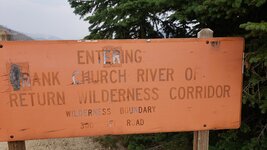
Eventually we made it out of the wilderness and down to the old abandoned Yankee Fork mining area where we camped for the night.
This year's trophy was awarded to a guy who brought his daily driver bone stock 20 year old Volkswagen Golf diesel and managed to make it all the way over the peak. That was a real Gambler move. There was a real possibility that he would not be making it to work on Monday, but he sent it anyway and made it.




The next morning after breakfast we packed up camp and parted ways. My codriver and I decided to check out a few noteworthy historical sites on the way back home. After lunch, we got gas in a little town and headed for Boise, expecting the adventure was over.
About 15 miles down the highway we saw a couple Gamblers pulled over in a turnout, so we stopped to check and make sure they were ok. Turns out one had run out of gas and was filling up from their spare gas cans. Two others had stopped to check on them before me. Moments later another Gambler pulled up to check on things. So at this point there are 5 Gambler cars on the side of the highway.
Suddenly we hear a bang and a horrible scraping noise. A truck towing a 5th wheel camper up the highway then pulled into the turnout next to us with big chunks of aluminum siding hanging off the side of his trailer. Turns out the camper had seen better days and had chosen that exact moment to unzip itself and start falling apart.
Conveniently, Gamblers expect vehicular carnage and come prepared, so this guy was in luck. We had the siding resecured with wood screws and duct tape within about 20 minutes and sent the guy on his way.
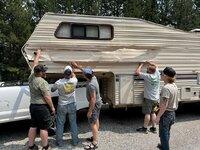


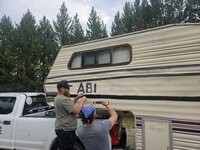
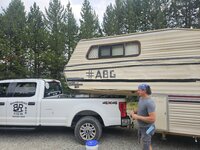
When I got back I put the car on the lift and inspected the damage. In no particular order:
The exhaust pipe is crushed and split open under the cv axle

Both rear control arm limit sensors for the roll bar are broken in half

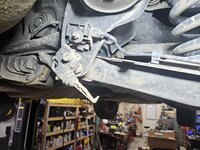
The cv axle boots are rubbing the air shock bags and have grooved them. They still hold air for now but maybe not for long.
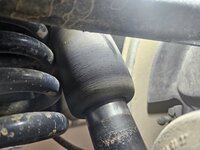
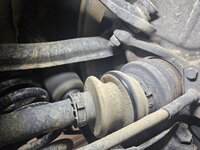
The front left strut is 100% blown out. The right side is not far behind.

And the steering box is leaking pretty badly.
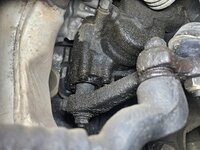
Not too bad, all things considered. It's all fixable, and it highlights where the weak points on the car were. I'll figure out a way to either upgrade, redesign, or protect each of these vulnerable parts to hopefully prevent similar damage in the future.
The next event is in early September, so I have just over a month to prepare.
The Gem State Gambler 500 was this past weekend. It was a ton of fun and the Offroadster did great. The revised rear suspension was terrific. Handled the rough terrain wonderfully.
This year's route took us through the mointains of central Idaho from just outside Lowman, Idaho up to Deadwood Reservoir, and the old abandoned Deadwood Mine, over Pinyon Peak, and on to Yankee Fork.
Starting from the Payette river, we climbed north, past several active forest fires, until we eventually reached the Deadwood Dam and its reservoir. We checked out the dam, and then continued along the east side of the reservoir, through a couple water crossings, and on to the old Deadwood Mine site.
Deadwood Mine is a pretty cool old mining camp. Several large structures still stand in the area, but they are in rough shape at this point.



The adventurous can do a little further exploring in the area and may discover this incredible waterfall hidden nearby.


From there we headed east and climbed up to Pinyon Peak at an elevation of 9945 feet. The SL was the only Gambler car to make it to the very top. Everyone else struggled so much just to reach the ridge line, and elected not to attempt the road to the summit lookout.

When we reached the summit we were greeted by a very friendly forest ranger who was puzzled and amused by the presence of a Mercedes convertible at the top of his mountain. He told us in all his years working fire lookout towers, he'd never seen anyone bring a vehicle like that to the top. He came out and took pictures of the car to share with his colleagues.
When we went up to the peak, the rest of the Gamblers continued on down the back side of the mountain. We were capable of traveling much faster than most of them, so we told them we'd just catch up with them on the way down.
That was both a good and bad decision. Once we said goodbye to our new Forest Ranger friends, we took off and started ripping down the mountain to catch up with the rest of our group. That was a ton of fun. Basically my own private offroad race course. I had the ASR turned off and the rear suspension raised all the way up and basically rally drifted my way all the way down the mountain. I mentioned before that we expected the automatic rollbar to get quite the workout on the trip. We had been counting rollbar deployments through the whole trip. We got to 10 on the way down the mountain, and then towards the bottom we reached a particularly rocky section that I hit with just a bit too much speed. The front skid plate slammed over the rocks and the car kind of bounced, and then the rear came down hard on the rocks. The roll bar deployed, and the car kept on moving with no major issues, but I could hear an exhaust leak, and then when I tried to lower the roll bar for the 11th time, it was unresponsive.
Oh well, I figured I'd done some damage, but the car was still running and driving fine, so we continued on like true Gamblers.
Part of the route took us through the Frank Church Wilderness area. Motorized travel is forbidden in wilderness areas, but there are some primitive trails that predate the creation of the wilderness designation where motor vehicles can continue to travel as long as they stick to the trail.


Eventually we made it out of the wilderness and down to the old abandoned Yankee Fork mining area where we camped for the night.
This year's trophy was awarded to a guy who brought his daily driver bone stock 20 year old Volkswagen Golf diesel and managed to make it all the way over the peak. That was a real Gambler move. There was a real possibility that he would not be making it to work on Monday, but he sent it anyway and made it.




The next morning after breakfast we packed up camp and parted ways. My codriver and I decided to check out a few noteworthy historical sites on the way back home. After lunch, we got gas in a little town and headed for Boise, expecting the adventure was over.
About 15 miles down the highway we saw a couple Gamblers pulled over in a turnout, so we stopped to check and make sure they were ok. Turns out one had run out of gas and was filling up from their spare gas cans. Two others had stopped to check on them before me. Moments later another Gambler pulled up to check on things. So at this point there are 5 Gambler cars on the side of the highway.
Suddenly we hear a bang and a horrible scraping noise. A truck towing a 5th wheel camper up the highway then pulled into the turnout next to us with big chunks of aluminum siding hanging off the side of his trailer. Turns out the camper had seen better days and had chosen that exact moment to unzip itself and start falling apart.
Conveniently, Gamblers expect vehicular carnage and come prepared, so this guy was in luck. We had the siding resecured with wood screws and duct tape within about 20 minutes and sent the guy on his way.





When I got back I put the car on the lift and inspected the damage. In no particular order:
The exhaust pipe is crushed and split open under the cv axle

Both rear control arm limit sensors for the roll bar are broken in half


The cv axle boots are rubbing the air shock bags and have grooved them. They still hold air for now but maybe not for long.


The front left strut is 100% blown out. The right side is not far behind.

And the steering box is leaking pretty badly.

Not too bad, all things considered. It's all fixable, and it highlights where the weak points on the car were. I'll figure out a way to either upgrade, redesign, or protect each of these vulnerable parts to hopefully prevent similar damage in the future.
The next event is in early September, so I have just over a month to prepare.
I had an idea for a limited slip diff. The 2002-2004 Ford Explorer used an 8.8 inch independent rear and is dimensionally pretty close to the 210mm diff. If equipped with the towing package, it would have been a 3.73 with a limited slip. They're also all over junk yards for dirt cheap.
Obviously it's not even close to a bolt in for this car, but I got some measurements off one today and I think it might be doable.
I'd have to make custom mounts obviously. That's no big deal. I can cut and weld and machine whatever I need for that.
The pinion yoke is obviously wrong. There are a few options there. I might be able to make an adapter to bolt the Mercedes isolator up to the Ford flange. I might also be able to just machine the Ford flange itself to accept the isolator. I could also alter the Mercedes driveshaft with a U joint end so it could bolt up to the afford flange.
The axle flanges would be interesting. The Explorer used CV axles that are splined directly into the differential. That means there is no flange. My hope would be to figure out some kind of stub shaft and flange that I can adapt to bolt the Mercedes CV axles to. The 8.8 is a bit narrower than the reinforced 210mm case in the 500SL, so I have a little room to work with for custom adapters if I can find stub shafts.
Wheel speed sensors are another issue. I've heard there's a way to move the wheel speed sensors out to the wheel hub. Does anyone know what's involved in doing that?
If I can find a stub axle that will work with the 8.8, and figure out a way to move the wheel speed sensors, I'll probably pick up an Explorer diff and give it a shot. If it works out, it might be an option for anyone wanting to upgrade their Mercedes.
Obviously it's not even close to a bolt in for this car, but I got some measurements off one today and I think it might be doable.
I'd have to make custom mounts obviously. That's no big deal. I can cut and weld and machine whatever I need for that.
The pinion yoke is obviously wrong. There are a few options there. I might be able to make an adapter to bolt the Mercedes isolator up to the Ford flange. I might also be able to just machine the Ford flange itself to accept the isolator. I could also alter the Mercedes driveshaft with a U joint end so it could bolt up to the afford flange.
The axle flanges would be interesting. The Explorer used CV axles that are splined directly into the differential. That means there is no flange. My hope would be to figure out some kind of stub shaft and flange that I can adapt to bolt the Mercedes CV axles to. The 8.8 is a bit narrower than the reinforced 210mm case in the 500SL, so I have a little room to work with for custom adapters if I can find stub shafts.
Wheel speed sensors are another issue. I've heard there's a way to move the wheel speed sensors out to the wheel hub. Does anyone know what's involved in doing that?
If I can find a stub axle that will work with the 8.8, and figure out a way to move the wheel speed sensors, I'll probably pick up an Explorer diff and give it a shot. If it works out, it might be an option for anyone wanting to upgrade their Mercedes.
It's been a busy month. I ended up running 2 other Gambler events in August and the car is doing great. I've made some additional modifications, including more suspension changes, as well as eliminating the rear control arm limit switches. I ended up ripping them off the car on two back to back events, so I decided to just get rid of them. This does mean the roll bar will not pop up automatically, so I'll just put it up with the manual switch if I decide to do anything sketchy.
Heading out tomorrow for another event. This one has a fun destination. We'll be heading to the Alvord Desert in southeast Oregon. The plan is to run our hoopties on the dry lake bed. Not sure how fast I'll be willing to push the Offroadster. Certainly triple digits, but with the big all terrain truck tires I'm not sure I really want to attempt anything over maybe 110.
I'm also trying to figure out a couple little issues with the car. First, it started misfiring at hot idle a couple days ago. It felt like it was down 4 cylinders. It barely idled, and could barely move at low speeds. Once the speeds and RPMs got going it seemed to smooth out. I ended up pulling both distributors apart and cleaning everything. I clearcoated the insulators and reassembled everything. It had been fine for a couple days, but then when I went to lunch today it started idling a bit lumpy as I parked. On the way home it was fine again. Not sure what's going on there.
The other issue is with the transmission. I'd installed a FGS valve body from a 400E, and that gas been working fine. The weird thing is that shifting to the B range doesn't always seem to work. Many times the car will shift to 2nd even with the shifter in B. Also, when I'm slowing down and want to drop to first in preparation for a corner exit, it'll stay in 2nd until I hammer the throttle. Once I mat it, the car will downshift, but it won't do it just by shifting to B. My 400E always responds when I shift to B. The SL usually doesn't. Any ideas what I should look at?
I had the car at an event a couple weeks ago where I had endless twisty dirt roads, just begging for rally drifting. It was frustrating that I couldn't always get 1st when I wanted it. Don't get me wrong, it was still an absolute blast, and I'm extremely glad I wired up the ASR defeat. I just wish I could get 1st every time I shifted to B so I could more easily link corners sideways.
Heading out tomorrow for another event. This one has a fun destination. We'll be heading to the Alvord Desert in southeast Oregon. The plan is to run our hoopties on the dry lake bed. Not sure how fast I'll be willing to push the Offroadster. Certainly triple digits, but with the big all terrain truck tires I'm not sure I really want to attempt anything over maybe 110.
I'm also trying to figure out a couple little issues with the car. First, it started misfiring at hot idle a couple days ago. It felt like it was down 4 cylinders. It barely idled, and could barely move at low speeds. Once the speeds and RPMs got going it seemed to smooth out. I ended up pulling both distributors apart and cleaning everything. I clearcoated the insulators and reassembled everything. It had been fine for a couple days, but then when I went to lunch today it started idling a bit lumpy as I parked. On the way home it was fine again. Not sure what's going on there.
The other issue is with the transmission. I'd installed a FGS valve body from a 400E, and that gas been working fine. The weird thing is that shifting to the B range doesn't always seem to work. Many times the car will shift to 2nd even with the shifter in B. Also, when I'm slowing down and want to drop to first in preparation for a corner exit, it'll stay in 2nd until I hammer the throttle. Once I mat it, the car will downshift, but it won't do it just by shifting to B. My 400E always responds when I shift to B. The SL usually doesn't. Any ideas what I should look at?
I had the car at an event a couple weeks ago where I had endless twisty dirt roads, just begging for rally drifting. It was frustrating that I couldn't always get 1st when I wanted it. Don't get me wrong, it was still an absolute blast, and I'm extremely glad I wired up the ASR defeat. I just wish I could get 1st every time I shifted to B so I could more easily link corners sideways.
Sounds like the "B" switch is not working, but the kickdown switch below the pedal is working correctly.The other issue is with the transmission. I'd installed a FGS valve body from a 400E, and that gas been working fine. The weird thing is that shifting to the B range doesn't always seem to work. Many times the car will shift to 2nd even with the shifter in B. Also, when I'm slowing down and want to drop to first in preparation for a corner exit, it'll stay in 2nd until I hammer the throttle. Once I mat it, the car will downshift, but it won't do it just by shifting to B. My 400E always responds when I shift to B. The SL usually doesn't. Any ideas what I should look at?
I'd focus on the "B" switch and see if you can verify that's triggering +12v at the solenoid when engaged.
It should shift exactly like the 400E, btw, given the same shift lever position / throttle position.

Yeah, that's what I figured. It's weird though, because sometimes it does work. Also, if I put it in B, and then tap the throttle to the floor, activating the kick down, then it will downshift to 1st and stay there. I wouldn't think it would do that if the B switch was bad.Sounds like the "B" switch is not working, but the kickdown switch below the pedal is working correctly.
Either way, I'll tear into it and have a look.
Similar threads
- Replies
- 3
- Views
- 274
- Replies
- 18
- Views
- 961
- Replies
- 17
- Views
- 1,209
- Replies
- 8
- Views
- 1,622
Similar threads
- Replies
- 3
- Views
- 274
- Replies
- 18
- Views
- 961


